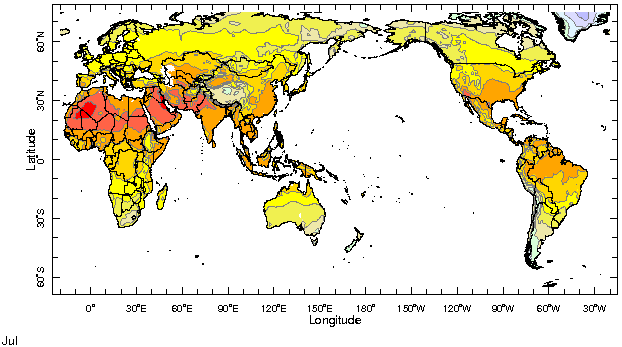|
IRI Climate Digest
August 2002
July Global Climate Summary
Climatological Background
In July, heating of the continents in the Northern Hemisphere results in strengthened monsoon systems which bring rains to West Africa, South Asia, and southwestern North America. In the Southern Hemisphere winter has set in with stronger north-south temperature gradients fueling active mid-latitude storm tracks.
Monthly Mean Temperature (1961-1990), data from the Climate Research
Unit, University of East Anglia


Monthly Mean Precipitation (1961-1990), data from the Climate Research
Unit, University of East Anglia


Temperatures
Highlights
South America Temperatures plunged to as low as -12 C in southeastern Peru during July with western and central Bolivia experiencing unusually cold weather as well. Heavy snow and icing conditions accompanied the cold in the higher elevations.
Europe/Western Asia Unusually hot conditions developed across southern and eastern Europe as well as western sections of the Former Soviet Union. Temperatures climbed above 40 C in some locations in southern Europe.
Temperature Difference from the 1961-1990 mean, with data
from NCEP Climate Prediction Center, CAMS.


Precipitation
Highlights
Africa Deficient rainfall continued across West Africa in the Sahel with shortfalls especially pronounced in Senegal and southern sections of Mali and Mauritania. Sporadic rains in the Greater Horn of East Africa were observed in western Ethiopia and southern Sudan.
India Extremes in precipitation occurred across India in July as very heavy rains and flooding affected the northeast of the country while a widespread and prolonged break in monsoon rains led to serious precipitation shortfalls elsewhere.
Australia/Indonesia Precipitation continued to be well below average across much of eastern Australia with some locations in New South Wales experiencing the driest April-July period in 100 years. Unusually dry conditions continued across much of Indonesia.
Canada Many areas of the Canadian Plains in south-central Alberta and Saskatchewan continue to be unusually dry with some sections experiencing their second consecutive year of drought.
Precipitation Difference from 1961-1990 mean, with data
from NCEP Climate Prediction Center, CAMS-OPI.


Oceanic Conditions
Tropical Pacific: Current conditions likely represent the early stage of an El Niņo as sea surface temperatures (SSTs) across much of the central and eastern equatorial Pacific are currently more than 1 degree C above their long-term average. SSTs were slightly lower than average in the far eastern Pacific near South America during July, however, El Niņo conditions are expected to persist through the remainder of 2002 into early 2003. Please see the latest IRI ENSO Update for a detailed summary and outlook.
Tropical Atlantic: Temperatures off of the West African coast north of the equator continued to be colder than average, while higher than average SSTs along the west coast of Southern Africa continued to diminish. Warmer than average temperatures off the southeastern coast of South America weakened somewhat from last month.
Indian Ocean: Surface temperatures continued to be warmer than average in the central and eastern basin while somewhat cooler than average waters were located in some western sections.
Mid latitudes: Colder than average surface temperatures continued in a broad west-east band extending from the eastern South Pacific into the southern South Atlantic basin. The south-central Indian Ocean remained cooler than average while much of the central North Pacific had somewhat warmer than average temperatures.
Monthly Sea Surface Temperature Difference from the 1950-1979 mean,
with data from the Environmental Modeling Center, NCEP/NOAA.


Contents |
Special |
Impacts |
Climate |
Forecast
| 
